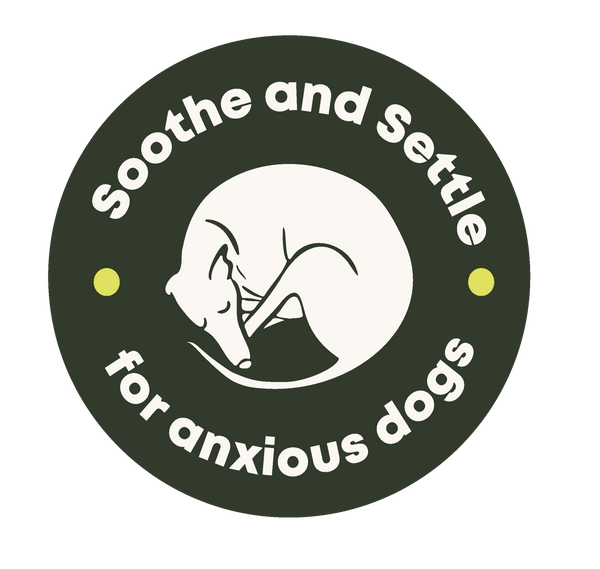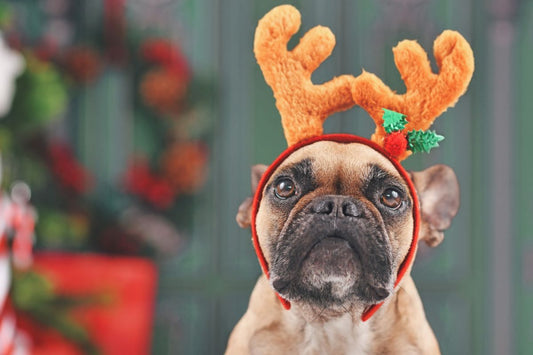
How to Keep Your Dog Calm During Fireworks
Share
Fireworks can be a stressful and terrifying experience for our dogs, and this can be just as difficult for owners to deal with. After all, nobody likes seeing their pup in distress without knowing what the best thing to do to help is!
In this guide, we’ll help you understand why dogs behave the way they do around loud noises and share our top tips and natural techniques to help you support your dog through the fireworks season.
Why Are Dogs Scared of Fireworks?
Before diving into strategies to keep your dog calm during fireworks, it's crucial to understand why they react the way they do.
Part of the problem stems from the fact that dogs hear more than twice as many frequencies as humans, and they can also hear sounds roughly four times further away than us.
Although dogs are often able to tune out unimportant sounds, when the boom, bangs, fizzes and flashes of fireworks start, it can be too much for some dogs, triggering their fight-or-flight response.
After all, dogs don’t know where the loud sounds and bright lights are coming from and have no way to escape them, so how do they know if they are safe?
There isn’t one reason for this fear response. However, in studies of fear responses to noises, researchers found that factors such as breed, age, sex, reproductive status, length of time with the owner, and early exposure to certain loud noises all impacted how dogs react to sounds like fireworks. In addition, it is thought that fear risk increases with age in dogs.
How to Tell if Your Dog Is Scared of Fireworks
Unsure if your dog is reacting to fireworks? Although every dog will react to differently, there are some tell-tale signs that your dog is scared of fireworks:
- Restlessness: Pacing, restlessness and constant movement may be a sign that your dog is agitated.
- Shaking or Trembling: Dogs may tremble or shake when they're feeling scared.
- Excessive Panting: Anxious dogs may pant heavier than usual, even if they haven't been exercising.
- Whimpering or Whining: Whimpering can be a sign of distress.
- Hiding: Dogs often hide under furniture or in a secluded area when they’re scared.
- Drooling: Excessive drooling can be a sign of stress in dogs.
- Loss of Appetite: Anxiety can cause dogs to lose interest in food.
- Dilated Pupils: Your dog’s eyes may appear wider than usual due to stress.
These are similar to the symptoms of anxiety in dogs which can be triggered by loud noises and other stress-inducing situations, such as separation from their owner, changes in environment or a medical condition.

How to Keep Your Dog Calm During Fireworks
If you’re looking for ways to keep your dog calm during fireworks, you’re not alone!
69% of UK adults with a pet take at least one measure to help relax or prepare their animal for firework season, and it is estimated that 45% of dogs show signs of fear when they hear fireworks.
These are our top natural strategies for keeping your dog calm during fireworks.
1. Counterconditioning / Desensitization
From the survey results, researchers identified that the most successful training technique was counterconditioning - giving desirable stimuli after loud noises. In other words, when the fireworks started, owners played with the dog, gave treats and expressed positive emotions to counteract the fear.
They found that dogs who received this counterconditioning were 70 percent less scared during fireworks, on average, than dogs who did not.
Bonus tip: Use treats to encourage your dog, but it's important that you use very high-value treats. By this, we mean treats that your dog wouldn't receive outside of training sessions (and treats that they'll find extra tasty!), otherwise this won't be as effective.
2. Hush Muff
Using ear or head coverings can help to reduce exposure to loud noises and calm your dog down.
At Soothe and Settle, we have created The Hush Muff, an anti-anxiety head covering with a unique, registered design, that is tailored to fit snugly around your dog's head. As well as muffling the impact of sudden loud noises, it wraps your pet in a gentle embrace for added comfort.
It is recommended that you introduce the coverings to your dog in a positive and relaxed environment before the fireworks season begins, and to monitor their behaviour while wearing the cover to check for signs of discomfort or distress.

3. Relaxation Training
Another effective method to keep dogs calm during fireworks is relaxation training.
This is where owners induce relaxation - such as through massage or long strokes - and then associate this with a word to classically condition a calm physiological state. This cue can then be used to induce relaxation during stressful events, such as fireworks.
Similar to counterconditioning, dogs can be progressively rewarded for behaviours, facial or bodily expressions consistent with relaxation, and in the face of gradually increased distractions.
4. Desensitisation Sounds
Desensitisation sounds are specifically designed to help dogs get used to loud noises like fireworks.
These tracks, which are available in CD format or on YouTube and other music streaming platforms, contain recordings of various noises, including fireworks, thunderstorms and other loud sounds, played at gradually increasing volumes.
This can help your dog become accustomed to the sounds of fireworks in a controlled and safe environment, and can be paired with other calming activities - such as treats, a massage or playtime - to reinforce positive associations with noise.
In one study, desensitization sounds were considered as effective in alleviating dogs’ firework fears by 54.4% of owners who had used them.
5. Create a Safe Haven
Using training or ear coverings in conjunction with creating a safe haven can be very effective.
Find a quiet spot where your dog will be comfortable, and create a “den” with their crate or bed, and some familiar toys, treats and blankets. If need be, close windows, draw curtains and play calming music or white noise to mask the sound of fireworks.
Bonus Tip: A microwavable heat bag for dogs provides additional warmth that can comfort your dog in stressful situations.
6. Massage
Massaging a dog doesn’t require any special equipment, but it can be an effective method to calm your dog down.
As Rover explains in their guide to dog massages, the most basic strokes are effleurage and petrissage. In effleurage, your hands apply gentle pressure as you move from one end of the muscle to the other between joints.
Unlike effleurage, which rubs the length of the muscle, petrissage targets its core using light, steady pressure.
To avoid accidentally injuring your dog never apply too much pressure or attempt to get at the deep tissue yourself.
7. Herbal Supplements
Natural herbs like chamomile, valerian root, passionflower and lavender have calming effects and can be given in supplement form to your dog.
When using herbal supplements for your dog, it's important to consult with your veterinarian first, especially if your dog has any underlying health conditions or is taking other medications. It's also important to use high-quality supplements from reputable sources to ensure they are safe for your dog to take.
These are most effective when used in conjunction with another calming technique, such as wearing ear muffs. I prepare my anxious dog Errol for loud noises by using the Hush Muff and giving him Dorwest Herbs supplements to make him as comfortable as possible.
8. Early Walk
Finally, ensure your dog gets plenty of exercise and mental stimulation during the day as this can help tire them out before fireworks start. Take them for a long walk or another high-energy, enrichment activity before the sun sets.
You might want to consider keeping their collar, harness or leash on when the fireworks do start, even when you’re at home, to help keep your dog close to you if they get startled by the noise.
How Long Does It Take a Dog To Recover from Fireworks?
Studies suggest that most dogs will recover by the next morning following firework exposure, but up to 15% of dogs can take one day to several weeks to recover.
Indeed, the recovery time for a dog after exposure to fireworks can vary depending on the individual dog's behaviour, the intensity of the fireworks, and the duration of exposure.
You can often help your dog to recover faster by offering comfort, reassurance and sticking to routine. If your dog is used to playtime and going for a walk, then make sure you still keep up these activities to help them return to a sense of 'normal' and calmness.
Conclusion
Fireworks can be a challenging time for dogs and their owners, but with the right strategies and preparation, you can help keep your pup calm and comfortable.
Remember, every dog is unique and the same technique that works for one might not work for the other, so it may take some trial and error to find the strategies that work best for you and your dog. However, patience and plenty of love will go a long way in helping them out.
Looking for natural herbal medicine for your pets needs?
We now stock top-rated Dorwest products, including Green Releaf tablets to support the urinary system, Tree Bark powder to support digestion and Valerian Compound to quickly calm and relax cats and dogs.





